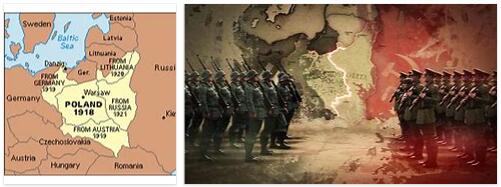Only at its beginning and its end did the Piasti dynasty give Poland truly eminent statesmen. Nevertheless, the progress made in the Polish lands between the century was significant. X and the sec. XIV. The first Piasti had carried out the work of pioneers: apart from the state and church organization of the country, it is up to them to have the merit of having begun the plowing of an extremely ungrateful land (forests and impenetrable swamps prevailed in ancient Poland); to have made internal communications and with neighboring countries safer and to have, in this way, brought Poland closer, even materially, to the West. In the twelfth and thirteenth centuries the dukes of the individual territories, the convents, the high clergy and the magnates improved the economic and agricultural conditions of their lands by introducing German peasants and bourgeois, governed by their own jurisdictions, which were then often extended to the Poles as well. The influx of German colonizers into Poland at times took on the character of a real movement of populations: uncultivated lands were reclaimed, crafts and commerce began to flourish. Casimir the Great, under whom this movement reached its maximum development, however, also favored internal colonization with Polish elements. And not only the countryside, but also the cities owe a lot to the last king of the national dynasty: the wooden houses were replaced by stone and brick constructions; in the main centers, and especially in Krakow, monumental churches and castles were built. To defend the town, several fortresses were erected. Poland thus quickly regained the time lost in the long struggles of previous centuries.
Not being able to settle in Poland, Louis of Anjou, shortly after his coronation, entrusted the regency of his new kingdom to his mother Elisabetta, sister of Casimir. The difficulties that ensued were indeed overcome by the energetic and compact conduct of the Krakow nobility, but the question, even more serious, of the succession arose immediately, since Ludovico also had no male heirs. To secure the right to the Polish crown for one of his two daughters he had to come to terms with the Polish nobility. The agreement was fixed in Košice in 1374, and the nobility obtained privileges that became the foundation of its future power: exemption from all taxes, compensation for damages in case of shipments outside the borders, guarantees that the king would not have conferred the high offices to foreigners. Strong of this his magna carta, the aristocracy forced the eleven-year-old Hedwig (Maria, the eldest, became queen of Hungary) to renounce her fiancé William of Hapsburg, designated by her father – who died in 1382 – and to accept the Lithuanian Jagiellon in his stead.
According to healthinclude.com, the move was very clever. Casimir had directed Polish policy towards the East, but here, on the detritus of the ancient Russian state, the Lithuanian power with which it was more prudent to collaborate than to fight had asserted itself with prestigious speed. Nor was the situation considered from the Lithuanian point of view different: rivalry between the descendants of Gediminas, aggression of the Teutonic Order, constant threat of the Tatars, gravitation of the Ruthenian territories towards Moscow, all made an agreement with the Poles advantageous. So it was that Jagiellon, shortly after Hedwig’s arrival in Poland, sent his ambassadors to Buda to ask for his hand and that immediately afterwards (1385) concluded an agreement with the Polish nobility in Krewo, with which he undertook to accept Christianity together. to all of Lithuania and to unite Lithuania with Poland. In the following year Krakow celebrated the baptism of Jagellone who took the name of Vladislao, his marriage to the young queen and finally the coronation of the new king. Another year passed and Vladislaus introduced Christianity to Lithuania, founded the bishopric of Vilna, subject to the metropolis of Gniezno, and bestowed the privileges enjoyed by the szlachta to those Lithuanian boyars who had accepted Christianity.
The pious Hedwig died very young in 1399, but in the few years in which she had reigned together with her husband who suffered the ascendant, she had been able to perform two acts of great importance: the reincorporation to the Polish crown of the cities of Red Ruthenia that her father would have liked. reserve for Hungary (and this peaceful conquest was spontaneously followed by the homage of the voivodes of Moldavia, Wallachia and Bessarabia) and the reorganization of the University of Krakow which, inaugurated a second time in 1400, soon became an important cultural factor in Central-Eastern Europe.
Vladislao Jagellone, on the other hand, was unable to fully fulfill the second commitment made to Krewo: that of incorporating the Grand Duchy of Lithuania into the Polish kingdom. It was opposed by his energetic cousin Vitoldo who, in order to obtain complete independence for himself and for Lithuania, did not hesitate at first to join the Teutonic Order. But then he was reconciled with Jagiellon and in agreement with him he subjected all of Lithuania to his power, which from then on until his death he ruled as Grand Duke.
